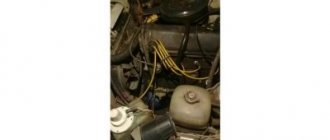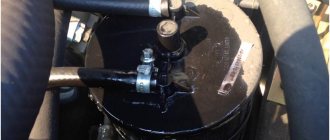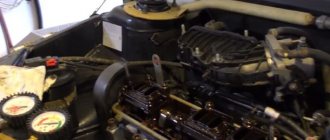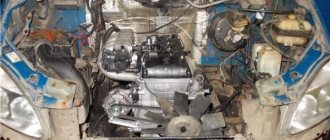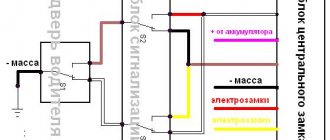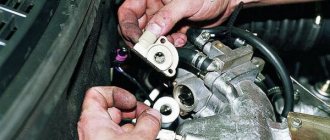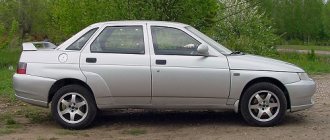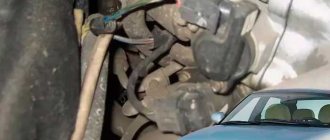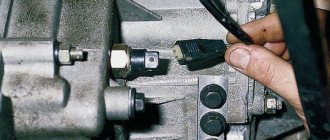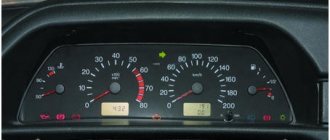Reasons why the check light is on for a VAZ 2110
1. Contamination or damage to the spark plugs is the first reason why the check light is on.
2.Damage to high-voltage wires.
3. Problems with the throttle valve.
4. Failure of the fuel mass flow sensor.
5.The use of low-quality fuel negatively affects the operation of the power unit.
6.Damage or breakdown of the oil pump.
7. Insufficient oil pressure in the system.
8.Problems in the operation of the ignition coils are also the reason why the check light is on.
9. Damage to the lambda probe.
10. Problems with the catalyst.
upvote this post!
Loading…
Troubleshooting Methods
Now that the main reasons have been identified - why the Check caught fire, you can move directly to methods for solving the issue. Of course, it is best to contact a car service to solve the problem, but many motorists, due to expensive repairs, try to solve the problem themselves.
So, before you start looking for a problem, you should connect to the electronic engine control unit and conduct a comprehensive diagnosis of all systems. To do this, you will need a laptop computer, a cable for connecting to the OBD 2 car and software that is suitable for this electronic control unit.
Having connected to the vehicle, it is necessary to carry out a comprehensive diagnosis of all systems, and then determine which errors have popped up and decipher them in order to determine the fault point. When everything is deciphered, you can proceed directly to troubleshooting.
Poor quality fuel
One of the most common reasons why the Check icons light up is low-quality fuel, which can often be found at gas stations. Thus, bad gasoline or diesel can clog fuel lines and its elements, which leads to effects such as tripping or stalling of the engine.
To fix the problem, you will have to drain the fuel from the entire system. It is worth noting that this process is quite labor-intensive and requires some knowledge in car design. Thus, you will have to remove the fuel tank and wash it, as well as replace elements that have become unusable.
Fuel pump and filter
Along with low-quality fuel, the fuel pump and filter suffer. Basically, the contamination of these elements leads to the fact that fuel does not flow in the required quantity, and this in turn leads to the appearance of a lean mixture, which can lead to high consumption or poor engine starting.
To eliminate the problem, you will have to replace the fuel filter. As for the gasoline pump, you will have to remove it from the car and replace the filter mesh, which is probably clogged. This procedure must be performed carefully, since you can accidentally damage the elements of the fuel pump.
Injectors
Another fuel element that is susceptible to low-quality fuel is the injector. Clogged elements can cause the engine to run rough. That is why this element occupies a high place in diagnostics.
In order to diagnose and eliminate the malfunction, you first need to remove the elements from the vehicle. Of course, some motorists recommend diagnosing and cleaning injectors directly on the car. But, to perform this operation, there is a special stand for washing injectors.
The injectors are disassembled and the nozzles are removed from them and installed in the stand. First, using different pressures, it is checked whether the nozzle is suitable for use. Then, if necessary, the element undergoes a cleaning process or is replaced with new ones.
Ignition system
Spark plugs and high-voltage wires also do not last forever. They tend to wear out, especially when the car owner does not carry out maintenance on them. One faulty wire and spark plug can be the reason why the Check sign is on.
So, in order to carry out diagnostics, it is necessary to dismantle the elements from the vehicle and use a multimeter to measure the performance of the elements. Also, it is worth doing a visual inspection of the parts for damage to the housing. Replace elements if necessary.
Possible reasons for the check to light up
It doesn’t matter whether the injector has 8 valves or 16. The information in this section will help identify the problem on both types of engines. First of all, it’s worth figuring out what malfunctions are causing the light to light up. Sometimes you can identify a breakdown without even taking the car to a service center.
Broken spark plugs
A common problem, as spark plugs begin to not work as they should over time. There may be several reasons, but the most common ones are:
- Carbon deposits have accumulated, causing the spark to not be very good.
- The gap has changed due to burnt electrodes.
- Ceramic insulation is broken.
- Malfunction due to long-term use.
- Failure of high-voltage wires. The insulation on them may be broken, which disrupts the operation of the system.
Advice! To eliminate such problems, you need to change spark plugs and high-voltage wires.
The spark plugs must be unscrewed and inspected for carbon deposits. It is also necessary to check for the presence of a spark: it must be clear and strong enough. It is important that all candles spark approximately equally.
Throttle problems
This option is possible if the machine has been in use for a long time. The reason may be a malfunction of the mechanical part due to wear or carbon accumulation near the valve. Sometimes the opening and closing mechanism itself gets stuck.
The second reason, which is the most common, is failure of the throttle sensor. You can independently determine its malfunction, but it is quite difficult. It is much easier to take the car to a diagnostic shop, where they will check its performance.
Malfunction of the mass air flow sensor
The check engine on the VAZ 2110 very often lights up due to the failure of the mass air flow sensor. This option can even be called a disease of this model, so many people start checking with it. You can determine the problem yourself - gasoline consumption will increase very much.
If the check light is on and the car takes much more fuel than usual, you should immediately go to a car service center and have the mass air flow sensor diagnosed. This breakdown can be repaired quickly enough, and spare parts are inexpensive, so you shouldn’t drive with it and consume a huge amount of gasoline.
Use of low-quality fuel
If the check engine light comes on shortly after leaving the gas station, the cause is likely to be low-quality fuel. Because of it, the operation of the injection system is disrupted, detonation appears, and traction deteriorates significantly. The idle speed may also fluctuate, and failures during acceleration are often observed.
By the way! A loose or loose tank cap can also be a culprit.
The engine control unit receives information from sensors about improper operation of the system, and a light comes on on the panel. If this happens, it is better not to operate the car, but to drain the bad fuel and fill it with normal fuel. If the problem occurs on the road, you can drain most of it and add good gasoline. This also helps.
Sometimes you come across fuel of such poor quality that you have to flush not only the tank, but the entire system. If this is not done, the injector may fail, and repairs will cost many times more.
Low oil pressure in the system
This option is also often the cause of the problem. There may be several reasons:
- Failure to comply with oil change schedules. Over time, the lubricant loses its properties, becomes liquid and becomes heavily contaminated. This prevents the pump from creating the required pressure in the system.
- Poor quality oil. This is not difficult to determine, because the light will light up shortly after replacing the lubricant.
- The oil pump is broken or is not working properly. Circulation is disrupted or stops altogether, which is very dangerous. If you drive with such a malfunction, the engine will fail due to overheating.
The channels through which lubricant flows may also become clogged. Most often, the reason for this is untimely oil changes, so you should not ignore the established periods.
For your information! You should first check the oil level in the pan. The reason may be a leak.
Problems with the ignition coils
Another option for why the check light is on is a malfunction of the ignition coils. They don't necessarily fail, but if there are any problems, it will inevitably lead to errors. It is necessary to check all connections to high-voltage wires, as they may be damaged.
Then test the coils. It’s easy to do this even with your own hands. If diagnostics reveal a problem, it is best to replace the coils as a set. There are 4 of them in the VAZ 2110, the price is low, so repairs will not be too expensive. You can change them yourself in a few minutes.
Burnt out catalyst
Another common reason for a signal to appear on the control panel. If this part of the exhaust system is burnt out, it can be easily determined by the loud exhaust sound and the smell that comes not from the pipe at the back, but from below. Sometimes there may be a connection problem.
Another option is that the catalyst is heavily clogged with soot, and therefore does not ensure normal passage of exhaust gases. In both cases, it must either be replaced with a new one or cut out. But if this part is removed, then it is worth inserting not a simple pipe, but a flame arrester so that the hot gases do not damage the remaining elements of the exhaust system.
Lambda probe failure
This element is installed only on 16-valve engines. It analyzes the composition of exhaust gases, helping to adjust the fuel mixture for its rational consumption. Over time, the sensor becomes covered with soot and fails.
It will not be possible to determine its malfunction visually. Only diagnostics will help. If it turns out that it is the lambda probe that has failed, it needs to be replaced. The sensor is unscrewed from the exhaust tract, the power connector is disconnected, and a new one is installed in the reverse order.
What can cause a check to “pop up”?
A lighted check may not always indicate a serious problem with the engine, but this signal from the car cannot be ignored. Below is a list of possible problems that may cause this signal to occur. 1. One of the most common problems is low quality gasoline. Draining the bad fuel and filling it with better quality usually helps. 2. The second most common cause could be a cracked spark plug insulator or improper spark plug gap. The best solution is to replace the spark plugs and check that their gap is exactly 1.3 millimeters. 3. The third reason is problems with the ignition coil. Usually it just doesn't spark. To check it, it is necessary to measure the output resistance, they should be values 1-4 and 2-3. 4. The fourth reason is a faulty lambda probe. There is only one solution - replacing this element; unfortunately, it cannot be repaired. 5. The fifth reason is a faulty catalyst. Just as in the previous case, there is only one solution - replacement. 6. The sixth reason is clogged nozzles. The solution is quite simple, but quite lengthy to implement - you need to clean them thoroughly. 7. The seventh most common reason is problems with the gas pump or the gas tank mesh. To clarify this reason, it is necessary to measure the pressure in the ramp. If the pressure is below three atmospheres, then you need to clean the mesh, and if this does not help, then replace the fuel pump. 8. The eighth reason happens extremely rarely, but it also causes the most problems. It lies in the high-voltage wires of the car. It is necessary to check all of them and, in case of malfunction, urgently replace them.
You should always remember that a lit check is important. After all, although this signal is a statement of the fact of a minor problem in the car, if it is not resolved in a timely manner, it may entail, at best, more complex and expensive repairs, and at worst, the car may fail while driving, and this is already dangerous to the life of the driver and his passengers. If the car owner himself does not have experience in eliminating this type of problem, then it is better for him to contact a specialized car service center, where experts in their field will eliminate all the malfunctions that have arisen.
If the check engine light comes on: 5 most common reasons for the “Check engine” light to turn on
What to do if the check engine light comes on: 5 most common reasons Many of us have encountered such a problem as turning on the engine icon (Check engine...), the appearance of which frightens car drivers. We offer you the 5 most common reasons why the check engine light comes on on the dashboard.
The engine warning light usually appears without warning. The reason for the appearance of the Check engine cannot be immediately understood. Even if the car has auto diagnostics (for example, in cars such as BMW, Audi, Porshe, Mercedes-Benz, VW), which scans all car systems for errors and, if any, displays a decryption on the information panel, the reasons for the check engine light will not be decrypted .
For most drivers, the appearance of this warning icon on the dashboard means the need to urgently go to a car repair shop to diagnose and eliminate the reason why the “Check Engine” warning sign appeared. But in fact, in most cases, when the “Check” indication appears, you can independently diagnose the cause of the engine failure and, in some cases, possibly eliminate the cause yourself without a trip to a car service center, which will save you money.
Popular on the site
Currently on the forum:
This page is searched for the following queries: Check engine light on for VAZ-2111, VAZ-2111 forum, discussion of VAZ-2111.
Currently commenting:
Jet black or grey-black
I would like to know the model of injectors, the type of internal combustion engine, the power supply system of the internal combustion engine..
Dimensions and tidy do not light up. CHY, all relays and presets are in order! New button! Backlight on p
On my smartphone it freezes every once in a while, then crashes, it says the pages could not be loaded
Thanks, I think so too
Often, when opening a page, it says that there is no such page, although a few minutes ago someone
Hello! I can’t find the lower rubber bands for the injectors, I found the upper ones, they fit from ten
Do not bother. Xenon in a headlight not intended for it is definitely already a collective farm. And St.
Mine doesn't understand. Is this the end of the update or what?
Wroom.ru
Media registration certificate No. FS 77-76203 16+
: Help the kettle. : New VAZ-2111 with an injector, after 3-5 minutes of operation the Check Engine lights up. After turning off everything is fine, but after 3-5 minutes of operation, even when parked, the same thing happens. : I'm sinning on gasoline (I filled up with 92), could this be causing the problem?
If after this the CE lights up again, then you still need to go to the diagnostics, where they will read the error code and tell you what to do or do.
This lamp comes on after about 1 minute if there is an old error in the memory. In this case, if you believe Dudar from VAZ and my experience, it will go out on its own after 2 hours of engine operation (in total). You can reset the memory by removing the terminal from the battery. But it's not worth it in vain. If it lights up immediately or while driving, you need to see a doctor for diagnosis.
If the Check engine indicator light comes on on the dashboard of your car (or simply the “check” is on), you should at least be wary. The reasons for this can be very diverse - from a loose gas tank cap to serious problems with the engine.
Reasons for the appearance and blinking of the “check” on the VAZ-2112
If we consider engines with a volume of 1.5 liters, we can talk about one of two internal combustion engines: VAZ-2111 (8v) or 21120 (16v). In the first case, the ignition module 2111-3705010 is used, in the second - 2112-3705010. These modules are not capricious and do not often require repairs. We have already written about diagnosing the ignition module and repairing it.
Ignition system of the “tenth” family
The following two tabs change content below.
- About the expert:
Experienced car enthusiast. First there was the VAZ-2107, then the Russian front-wheel drive, then foreign cars, there were even right-hand drive ones. I try, like a “doctor,” to look and listen to the car completely. I give each of my vehicles a name.
The modules themselves, as you can see, are different, but they have the same “disease”. It is not the module that is to blame here, but its high-voltage connectors. The terminal may move away from any of the four connectors, but nothing will change externally. And after a while the terminal on the cable will burn out. Then the engine will begin to “trouble” and misfires will be noticed by the controller. Therefore, constant checking of the ignition module is necessary.
Let's clarify: at first the terminal comes off, but the current is carried out. Then charring occurs. On the dashboard of any car, including the VAZ-2112, the check will not light up immediately. And as soon as it lights up, check the contacts!
Two cases from practice
This is what happens in reality. The owners write:
- For some reason, the check light starts flashing when the speed exceeds 100 km/h;
- The lamp blinked only after warming up to 100 degrees;
- Etc.
There are many cases, but the reason is one. Contact can be disrupted by vibration, although in the first case they talk about speed. Well, thermal expansion also cannot be discounted.
What exactly needs to be done
Check the cap on each of the wires: if the copper is burnt, clean it with ASIDOL, ammonia and ordinary chalk. The taps on the module should also be cleaned. For better protection, you can apply lithium grease (Litol-24).
Litol will help us
Here's what you can't do:
- Check for the presence of a spark by bringing a “grounded conductor” to the tap;
- Connect the “+” terminal removed from the battery to ground with the engine running;
- Apply voltage “+12” to any of the module contacts.
How to perform an express check: the key is at “0”, then we measure the resistance between taps 2-3, 1-4. Both values must match. By the way, the multimeter must be a dial gauge.
Precautions: When connecting the multimeter to the module, do not touch two probes with your hands at the same time. The measurement limit is 100 kOhm or 10 kOhm.
How to distinguish “gaps” from everything else
Let's consider the situation: it is difficult to start when hot. If it starts when cold, the check light then turns on, but after 20-30 minutes it goes out. In this case, we can conclude that there is a misfire. Well, they can even be caused by an insulation breakdown. And above we looked at what is typical for the 2112 family (but not for the 21124 engine).
This block is too smart
They may say that the check for the VAZ-2112 caught fire for no reason. This happens in cases where:
- The indicator turns on, then the engine is turned off and the battery is disconnected (disconnect the minus terminal for 10 minutes);
- After connecting the battery, no defects are observed. Start the engine - the check lamp does not light up.
In fact, the ECU actually remembers any defect (the occurrence of any error). But the “reset” is also performed by the system itself:
- When starting the engine;
- After the next test cycle.
For each error, one of two methods is used. And, in theory, there is no point in disconnecting the battery. If the “check” is constantly on, then you need to look for a defect. And “terminal tricks” usually don’t help.
Why did the light come on and how to fix it
The main situations in which the indicator lights up and the recommended courses of action for the car owner:
If the Check engine lights up and goes out immediately when starting the car, there is no damage to the engine. The cause of the fire is most likely harmless - the fuel tank cap is lost or not screwed in properly. Just wrap it tightly and check if the warning disappears. If the indicator lights up while driving, you should stop and check the wires. You may find a cable hanging loose under the hood or an open battery terminal. This applies to all attachments - wires, hoses, etc.
d. If the light flashes while driving, you should stop and check the sounds made by the engine, pay attention to the oil level, and inspect the sides of the engine. If no visually obvious violations are detected, it is recommended to drive to the nearest car service center and carry out diagnostics. If the engine is running normally and the Check light is constantly flashing, there is most likely an ignition failure.
You should check the spark plugs and coil, pay attention to the quality of the fuel. To do this, it is better to contact the nearest auto diagnostic center. If the indicator is constantly on, you need to stop, unscrew the spark plugs and check the gap. Gaps that exceed 1.3 may cause the light bulb to burn out. In addition, when the “check” is on, the ignition is usually checked. Any car service center has special testers that allow you to determine the wear of wiring insulation. The cause of the light coming on can also be a faulty fuel pump. You should stop and listen to the sounds the fuel pump makes. A smooth hum without clicks or pauses is considered normal. If extraneous sounds appear, the pump should be dismantled, washed inside and the filter cleaned. Serious engine malfunctions can be indicated by the coolant temperature. If it is above 85–90 degrees, and the Check engine lights up while driving, the engine is definitely faulty. In this case, it is advisable to call a tow truck or drive at low speed to the nearest car service center.
Table: reasons for the Check engine light to come on and suggested actions
| When and in what cases does the “check” light come on? | Possible reasons | Suggested Actions |
| When driving, when accelerating | Harsh acceleration, faulty air filter | Replace filter, accelerate smoother |
| When the indicator flashes, the engine starts | The fuel in one of the cylinders does not burn completely; the gasoline either burns out in the exhaust pipe or immediately enters the catalyst | Replace spark plugs, check coil and armored wires, check timing marks |
| After refueling | Low fuel quality | Change gas station |
| When the ignition is turned on | Normal car reaction | Nothing should be done |
| After washing the car, engine, after rain | Water got into the Check engine wiring | Treat with WD40, dry, clean contacts |
| Cold | Knock sensor faulty | Replace |
| On a hot engine | Camshaft sensor faulty | Replace |
| At high speeds | Missing ignition coils or faulty crankshaft sensor | Replace coil or sensor |
| At idle | Throttle sensor malfunction | Replace |
| After replacing spark plugs | “Poor” combustible mixture | Change the octane number of gasoline to a higher one |
| After replacing the air filter | More air began to flow, the composition of the exhaust changed, the lambda probe reacted | Turn off the engine and start again |
| After replacing the timing belt | A terminal has come off from some sensor, most likely the air hose | Check terminals |
| After installing gas equipment | Fuel injector emulation is done incorrectly | Tune |
| After installing the alarm | Only one power line is connected to the turbo timer, the second one contains a temperature sensor, brake pedal and mass air flow sensor | Reset Check engine, connect both lines |
| After replacing the fuel filter | Low pressure filter installed | Replace filter |
| With a simultaneous increase in fuel consumption | Driving too long, oxygen heating up or poor quality fuel | Refuel with high-quality fuel and give the car a rest |
| On long climbs | Worn timing belt, faulty sensors | Check and replace |
| After replacing the ignition module | Module connection problems | Remove and reconnect the positive terminal from the battery |
| At sub-zero temperatures | Malfunction of the throttle position sensor or disconnection of its chip | Replace the device or replace the chip |
| When you press the accelerator pedal | Air filter clogged | Clean or replace the filter |
Is it possible to drive the car?
Some people drive for months and even years with a burning check, so many people think that there is nothing wrong with this and they can move around calmly if the engine is running. In reality, everything is not so simple. Breakdowns can be different. You can drive with one with virtually no changes in engine operation, but the second will cause big problems after a few hundred or even tens of kilometers.
Therefore, if possible, it is worthwhile to find out as quickly as possible what is causing the light bulb to burn. After this, make a decision about whether it is worth moving by car or whether it needs to be repaired.
Damage to the mass air flow sensor
The faulty engine warning light may also come on if there are problems with the air flow meter. Such a sensor (mass air flow sensor) often fails or starts to work incorrectly, which leads to problems with the motor. Problems with the mass air flow sensor in the VAZ 2110 engine can be indirectly determined by significantly increasing fuel consumption. Note that it is not recommended to operate an engine with such breakdowns, so if the Check Engine light comes on and fuel consumption increases, it is best to go to a service center and carry out high-quality computer diagnostics. The cost of spare parts and repair work in this case is not too high, which will allow you to fully restore the functionality of your car.
Refueling with low-quality fuel
The Check Engine light may come on immediately after refueling with low-quality fuel. Such dirty and low-quality fuel, entering the engine, invariably causes increased detonation and improper operation of the injection system, and as a result, the engine control unit receives errors from the built-in sensors and a check light on the dashboard lights up. If such an alarm lights up immediately or shortly after refueling, it is most likely due to low-quality fuel. It is not recommended to operate the car in this case. You need to call a tow truck and take the car to a service center, where specialists will comprehensively diagnose the car and clean the fuel system. Otherwise, the injector may be damaged, which will lead to expensive engine repairs.
The engine does not pull, where to look for the reasons
In the life of motorists, a situation often arises when, when driving out onto the road and trying to accelerate, it is noted that the engine does not pull.
That is, the acceleration dynamics are very “sluggish”, the car is reluctant to pick up speed, and it feels like something is holding it back.
This problem can arise with almost any car - domestic or foreign, gasoline or diesel, with a carburetor power system and injector.
Often, a drop in traction is accompanied by additional symptoms - extraneous sounds appear when the engine is running, the engine may stall in one of the modes (usually at idle), the crankshaft speed is not stable and “floats”.
How to fix the problem?
First you need to identify the reason why the check light came on. Since there are many options, diagnosis is carried out first. It will help you identify a specific problem in order to understand what needs to be repaired and how. Procedure:
- You can try self-diagnosis. This function is available in the on-board computer. Everything should be done as described in the operating instructions. There are also error codes that can help you identify the problem. But this method is not very effective; it only helps sometimes.
- Computer diagnostics are much more accurate. With its help, you can determine the malfunction by code. It won’t be difficult to find a broken sensor or determine problems in the operation of components.
There are many videos on the Internet - they explain the reasons for the appearance of the check and show how to repair it. You can watch this video to better understand the topic.
Signs
How do you know if the engine is leaking? With such a malfunction, the check engine light does not always flash. Therefore, it is important to know third-party signs that may indicate a problem:
- Increased engine vibration. It is significantly noticeable at low and idle speeds.
- Spark plug color change. After removal, its head will be dark. Since the mixture does not ignite, the candle becomes covered with soot and soot.
- Increased fuel consumption. This sign is related to the previous one. Since the mixture does not ignite, it simply goes into the exhaust pipe.
- Loss of engine power. Since the engine runs on three cylinders, it does not have enough energy to produce the required torque.
- Exhaust sound. He will be unstable.
- The appearance of black or thick white smoke from the exhaust pipe.
- Intermittent jolts during acceleration and even motion. This symptom also indicates a misfire. This error is often related to the ignition system.
It is worth listening carefully to the nature of the engine. If the friction increases at medium and high speeds, it can be assumed that the valves in the engine are not working properly. One simple reason is increased valve clearance.
In any case, if one or more of the above symptoms are detected, it is worth taking corrective action.
Lambda probe failure
On 16-valve modifications of the VAZ 2110 engine, a lambda probe is installed, which is responsible for analyzing exhaust gases. Over time, a layer of used oil appears on the surface of such a lambda probe, which leads to problems with the accuracy of the sensor’s readings. As a result, the Check Engine light comes on, and the car must be taken to a service center. It is impossible to independently determine the problem with the lambda probe. Only when diagnosing a car using special equipment can you determine the corresponding error codes, on the basis of which problems with the lambda probe will be identified. This element cannot be repaired and if it breaks, it is simply replaced with a new one.
Burnt out catalyst
Problems with the catalytic converter can also cause a Check Engine Light. Such problems can be indirectly identified due to the appearance of an uncharacteristic exhaust sound, while the engine begins to smoke heavily. It is necessary to check the catalyst at a service station and if problems with this unit are identified, it must be replaced with a new one or cut out. It is not recommended to use a car with a damaged catalyst, as this can lead to various types of serious damage, including the need to overhaul the power unit.
Purpose of the Check indicator
The Check light is located on the dashboard of the car. It is usually yellow or orange in color and can be made in various variations.
The Check light can be produced in various versions
The name of the Check Engine light literally translates from English as “check engine.” The reasons for its fire can be very diverse - from a loose gas tank cap to serious problems with the engine.
When you start the engine, all the lights on the dashboard come on and then go out, including the Check light. This is how a test for the performance of indicators is carried out. In other cases, when the light comes on, the car owner should at least be wary.
What else do you need to think about?
We were able to describe several of the most frequently repeated cases of this signal lighting up. The engine designs of different cars differ, so there may be other reasons for the appearance of an alarm signal. It will be best for you and your car if computer diagnostics of all car systems is carried out. To do this, you can use the services of specialized centers, but some “advanced” drivers do this on their own.
Pay more attention to your “iron horse”, use only high-quality fuel and consumables, then you won’t have to worry about why the check light comes on when driving. And if you do see an “alarming” signal, do not rush to extremes, but delve into the problem and eliminate it.
